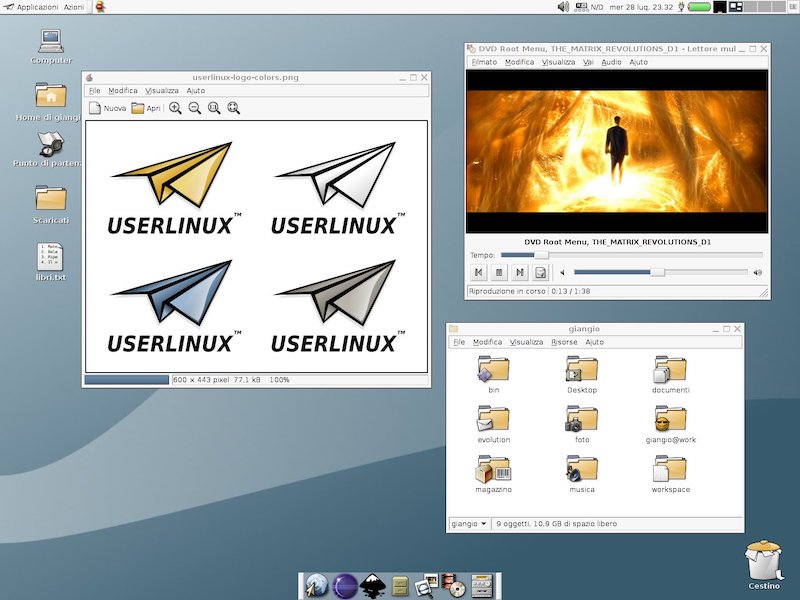20 years of Linux on the Desktop (part 1)
by Ploum on 2024-10-20
Twenty years ago, I had an epiphany: Linux was ready for the desktop.
(*audience laughs*)
I had been one of those teenagers invited everywhere to "fix" the computer. Neighbours, friends, family. Yes, that kind of nerdy teenager. You probably know what I mean. But I was tired of installing cracked antivirus and cleaning infested Microsoft Windows computers, their RAM full of malware, their CPU slowing to a crawl, with their little power LED begging me to alleviate their suffering.
Tired of being an unpaid Microsoft support technician, I offered people to install Linux on their computer, with my full support, or to never talk with me about their computer any more.
To my surprise, some accepted the Linux offer.
I started to always have two CD-ROMs with me: the latest Knoppix and Debian Woody. I would first launch Knoppix, the first Live CD Linux, make a demonstration to my future victims and, more importantly, save the autogenerated XFree86 config file. I would then install Debian. When X would fail to start after installation, which was a given, I would copy the X config file from Knoppix, install GNOME 2 and OpenOffice from the testing repository and start working on what needed to be done. Like installing and launching ESD by default to allow multiple sounds. Configuring the network which was, most of the time, a USB ADSL modem requiring some proprietary firmware that I would have downloaded beforehand.
I would also create some shell scripts for common operations: connect to Internet, mount the USB camera, etc. I put those scripts on the GNOME desktop so people could simply click to launch them. In some cases, I would make a quick Zenity interface.
It was a lot of work upfront but, after that, it worked. People were using their computer for months or years without messing or breaking anything. Most of my complains were about running some windows software (like those on CD-ROM founds in cereal boxes).
With GNOME 2.0, I felt that Linux was ready for the desktop. It was just really hard to install. And that could be fixed.
The Perfect Desktop
I had my own public wiki (called the FriWiki) with a few regular contributors. On it, I wrote a long text called: "Debian+GNOME=The Perfect Desktop?". It explained my observations and all the problems that needed to be fixed.
As I wanted to improve the situation, I described how the installation should autodetect everything, like Knoppix did. I also suggested to have a LiveCD and an Installation CD that would be totally mirroring each other so you could test then install. In a perfect world, you could install directly from the LiveCD but I didn’t know if it was technically possible. That installation should also offer standard partitions schemes, autodetect and preserve the Windows partition so people would not be afraid of messing their system.
Installation was not everything. I suggested that the user created during installation should automatically have root rights. I had learned that two passwords were really too high of a bar for most if not for all people. I don’t remember anyone understanding the "root" concept. Systems with multiple users were too complex to teach so I ended in every case with a single whole family account. The fact that this single account was prevented from doing some stuff on the computer was baffling. Especially for trivial things such as mounting a CD-ROM or a USB key.
Speaking of root: installing software could be really more friendly. I imagined a synaptic-like interface which would only display main applications (not all packages) with screenshots, descriptions and reviews. I did some mockups and noted that the hardest parts would probably be the selection and the translation. I’ve lost those mockups but, in my souvenirs, they were incredibly close of what app stores would become years later.
I, of course, insisted on installing ESD by default to multiplex sound, to include all the multimedia codecs, lbdvdcss and all possible firmware (called "drivers" at the time) in case hardware is added later.
I had pages and pages of detailed analysis of every single aspect I wanted to be improved to make Linux ready for the desktop.
With 2.0, GNOME switched to a bi-yearly release. Every six months, a new GNOME desktop would be released, no matter what. I thought it would be a nice idea to have the underlying OS released just after, to be kept in sync. But every six months was probably a bit too much work and people I knew would not upgrade as often anyway. So I advocated for a yearly release where the version number would be the full year. This would greatly help people to understand what version they were running. Like in "I’m running Linux Desktop 2003".
UserLinux
When you have a good idea, it’s probably because this idea is already in the zeitgeist of the time. I don’t believe in "ownership" or even "stealing" when it’s about ideas. Bruce Perens himself was thinking about the subject. He decided to launch UserLinux, an initiative that had the goal of doing exactly what I had in mind.
I immediately joined the project and started to be a very vocal member, always referring to my "Perfect Desktop" essay. I wanted UserLinux to succeed. If Bruce Perens was behind it, it could not not succeed, right?

Unfortunately, most of UserLinux people were, like me, talking a lot but not doing much. The only active member was an artist who designed a logo and started to create multiple GNOME themes. It was great. And lots of discussions about how to make the theme even better ensued.
This is how I learned about "bike shedding".
UserLinux was the ultimate bikeshedded project. To my knowledge, no code was ever written. In fact, it was not even clear what code should be written at all. After launching the initial idea, Bruce Perens was mostly discussing with us, everybody waiting for someone to "do something".
No-name-yet
At the start of 2004, I was contacted by Sébastien Bacher, a Debian developer who told me that he had read my "Perfect Desktop" essay months ago and forwarded it to someone who had very similar ideas. And lots of money. So much money that they were already secretly working on it and, now that it was starting to take shape, they were interested in my feedback about the very alpha version.
I, of course, agreed and was excited. This is how I joined a mysterious project called "no-name-yet" with a nonameyet.com website and an IRC channel. While discussing about the project and learning it in great depth, my greatest fear was that it would become a fork of Debian. I felt strongly that one should not fork Debian lightly. Instead, it should be more a few packages and metapackages that would sit on top of Debian. Multiple people in the team assured me that the goal was to cooperate with Debian, not to fork it.
At one point, I strongly argued with someone on IRC whose nick was "sabdfl". Someone else asked me in private if I knew who it was. I didn’t.
That’s how I learned that the project was funded by Mark Shuttleworth himself.
Dreaming of being an astronaut, I was a huge fan of Mark Shuttleworth. The guy was an astronaut but was also a free software supporter. I knew him from the days when he tried to offer bounties to improve free software like Thunderbird. Without much success. But I was surprised to learn that Mark had also been a Debian developer.
This guy was my hero (and still kinda is). He represented all of my dreams: an astronaut, a debian developer and a billionaire (in my order of importance). Years later, I would meet him once in the hall of an Ubuntu Summit. He was typing on his laptop, looked at me and I could not say anything other than "Hello". And that was it. But I’m proud to say that his hackergothi on planet.ubuntu.com is still the one I designed for him as a way to celebrate his space flight.

During the spring or early summer of 2004, I received a link to the very first alpha version of no-name-yet. Which, suddenly, had a real name. And I liked it: Ubuntu. I installed Ubuntu on a partition to test. Quickly, I found myself using it daily, forgetting about my Debian partition. It was brown. Very brown at first. A bit later, it even got naked people on the login screen (and I defended sabdfl for this controversial decision). Instead of studying for my exams, I started to do lengthy reports about what could be improved, about bugs I found, etc.

This makes me one of the very few people on earth who started to use Ubuntu with 4.04 (it was not named like that, of course).
Wanting to promote Ubuntu and inspired by Tristan Nitot, I decided to start a blog.
A blog which, coincidentally, was started the very same day the first public Ubuntu was released, exactly twenty years ago.
A blog you are reading right now.
And this was just the beginning…
Subscribe by email or by rss to get the next episodes of "20 years of Linux on the Desktop".
I’m currently turning this story into a book. I’m looking for an agent or a publisher interested to work with me on this book and on an English translation of "Bikepunk", my new post-apocalyptic-cyclist typewritten novel.
I’m Ploum, a writer and an engineer. I like to explore how technology impacts society. You can subscribe by email or by rss. I value privacy and never share your adress.
I write science-fiction novels in French. For Bikepunk, my new post-apocalyptic-cyclist book, my publisher is looking for contacts in other countries to distribute it in languages other than French. If you can help, contact me!